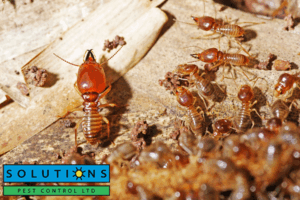If you’ve spotted damage to wooden structures in your North Vancouver home or garden shed, you may be wondering if it’s from termite larvae or another pest, like carpenter ants. Whether you’ve seen holes, frass, or hollowed-out wood, it’s important to identify the cause early. The damage from termite larvae can be extensive if not dealt with quickly, so understanding how to prevent it and knowing the costs involved in treating an infestation is essential. Let’s take a closer look at how to recognize the difference between termites and carpenter ants, explore natural solutions for treatment, and dive into what you can expect when it comes to the cost of termite control in North Vancouver.
What Does Termite Larvae Damage Look Like Compared to Carpenter Ants, Which Are Also Common Around North Vancouver?
Identifying Termite Larvae Damage
Termite larvae cause damage that’s typically more hidden than what carpenter ants produce. When termites feed on wood, they do so from the inside out. This leads to soft, hollowed wood with tiny, pinprick holes. If you look closely, you might also notice frass, sawdust-like debris that termites push out of their tunnels. This type of damage often occurs in hidden areas like crawlspaces, baseboards, and furniture, making it hard to spot until it’s too late.
Carpenter Ant Damage
Carpenter ants, while also a concern for North Vancouver homeowners, cause a different type of damage. They don’t feed on the wood but excavate it to build their nests. The holes they leave are larger and more noticeable than termite larvae damage. Unlike termites, carpenter ants don’t leave behind frass, they push it outside their nests. Carpenter ant damage is usually localized to wooden structures like beams or insulation, and you might find these ants during summer months when they are more active.
Why It’s Important to Differentiate
It’s crucial to identify whether you’re dealing with termites or carpenter ants early on because their damage differs significantly. Termite larvae can undermine the structural integrity of your home over time, while carpenter ants generally focus on less severe damage to wooden structures. Understanding the type of pest is the first step in choosing the right treatment and preventing further issues.
What’s the Best Way to Get Rid of Termite Larvae Naturally, Especially in a North Vancouver Garden Shed?
Natural Solutions for Termite Larvae Control
If you’re dealing with a smaller termite larvae infestation, especially in a garden shed, natural solutions can help control the issue without the need for chemicals. One highly effective natural method is using essential oils like orange, neem, or eucalyptus oil. You can dilute these oils with water and spray them directly onto the affected areas to repel termites. These oils act as a deterrent and, in some cases, can even kill termites upon contact.
Diatomaceous Earth
Diatomaceous earth is another excellent natural solution for termite larvae. This powder, made from fossilized algae, works by dehydrating termites when they come into contact with it. It’s safe for pets and plants, making it ideal for garden sheds or any areas close to your landscaping. Simply dust it around the affected area, and it will help eliminate termites over time.
Beneficial Nematodes
For a more targeted approach, beneficial nematodes are microscopic worms that hunt down termite larvae in the soil. They’re safe for the environment and can be an excellent solution for areas where termites are nesting in the soil around wooden structures. Nematodes are easy to apply and can help naturally reduce the termite population.
Preventing Future Termite Infestations
After addressing the immediate problem, take preventive steps to prevent termites from returning. To make your garden shed less attractive to termites, remove wood piles or other debris near the structure. Proper drainage and ventilation are essential in reducing moisture, which termites find appealing. Sealing entry points such as cracks or gaps in your shed’s foundation will further deter them from settling in.
How Much Does It Typically Cost to Treat a Termite Larvae Problem in North Vancouver, and Do Prices Vary by Neighborhood?
Average Costs for Termite Larvae Treatment in North Vancouver
If you need professional help to deal with a termite larvae infestation, you can expect to pay anywhere from $500 to $2,000 or more. The cost typically depends on the size of the infestation, the extent of the damage, and the type of treatment required. The price often includes the initial inspection and treatment, as well as follow-up visits to ensure the problem is fully resolved.
Do Prices Vary by Neighborhood in North Vancouver?
Yes, pricing for North Vancouver pest control services can vary by neighborhood. In areas with older homes or properties closer to wooded areas, like those near Grouse Mountain or Deep Cove, you may see higher rates due to the increased likelihood of termite infestations. Homes in more suburban areas or further from forests might have slightly lower treatment costs. Additionally, the cost of living in certain neighborhoods could influence the price of services.
How to Save on Treatment Costs
To keep costs down, it’s a good idea to catch termite larvae problems early. The longer you wait, the more extensive (and expensive) the treatment becomes. You can also save money by getting multiple quotes from local exterminator North Vancouver companies to ensure you get the best value. Many pest control companies also offer discounts during the off-season or for regular maintenance plans, which can be a cost-effective way to protect your home from future infestations.

Preventing Termite Larvae Damage in North Vancouver Homes
Regular Inspections and Maintenance
One of the most effective ways to prevent termite larvae damage is through regular inspections. Pest control North Vancouver experts recommend annual inspections for homes with wooden structures or those located near wooded areas. Regular maintenance, such as inspecting for cracks, leaks, or moisture buildup, can significantly reduce the risk of termite infestations.
DIY Tips for Protecting Your Home from Termites
While professional help is important, there are steps homeowners can take to reduce the risk of termite infestations:
- Seal cracks and gaps around windows, doors, and vents to keep termites from entering.
- Remove wood and debris from around the foundation and garden shed to prevent termites from finding food sources.
- Control moisture by fixing leaks and ensuring proper drainage around your property.
When to Call a Professional
If you’re dealing with a large termite larva infestation, it’s time to call a professional pest control in North Vancouver. A pest control expert has the knowledge and tools to identify the extent of the infestation, apply effective treatments, and prevent further damage. Don’t wait for structural damage; taking action early can save you time and money in the long run.
Conclusion
Termite larvae damage in your North Vancouver home or garden shed doesn’t have to lead to costly repairs. By understanding how to identify termite larvae and using natural treatments for smaller infestations, you can prevent further damage to your property. However, when the problem becomes larger, it’s important to call in a professional termite control near me service to handle the situation effectively. Regular inspections and maintenance are key to protecting your home from termites, and with the right approach, you can keep your property safe for years to come. Ready to protect your home? Contact a North Vancouver pest control expert today to schedule an inspection and safeguard your property from termite damage.


